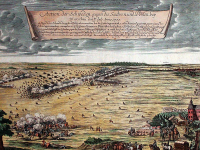The Great Northern War evolved from Sweden's policy of expansion, which governed the country under the reign of Charles XI. to grow a major power in the Baltic Sea region. After his death in 1697 was followed by his son Charles XII. and an anti Sweden alliance saw his chance come to take action against Sweden.
Background:
As 1697 Karl XII. he had just entered the Swedish throne when he was just 15 years old and ruled over a country which, in addition to present-day Finland, still included parts of neighboring Russia, the Baltic region and areas in northern Germany. Under his father Karl XI. Sweden expanded under an aggressive policy, which appalled coastal states in the Baltic Sea region. So it happened that after their death, Poland, Denmark and Russia allied to make war against Sweden.
The war:
On February 12, 1697 fell to the Saxon Elector Friedrich August I, who was at the same time King of Poland (August II, the Strong), without a declaration of war on Sweden in its territory Livonia. The allied Danes under Frederick IV declared war on Sweden on March 11th. A joint attack against the Swedish troops failed, Karl pulled out to counter strike and conquered in July Copenhagen. Denmark was forced to conclude a peace treaty with Sweden on August 8, 1700 in Traventhal.
Meanwhile, August besieged the city of Riga in the hope that the nobles would rise, then revolt against him and against the Swedes. But the hoped-for uprising failed and he had to retire.
Russia, which was governed by Peter I from 1696, also intervened in the conflict. Peter wanted to expel the Swedes from the Baltic region by means of a campaign and incorporate their own access to the Baltic Sea into their land. For this he besieged Narva, located southeast of 1702 St. Petersburg. But the army of Karl could beat the Russian force and push back.
At that time, no army of the Alliance had grown to the Swedish troops, but Charles wanted to expand his empire further and also had a personal aversion to August, who had converted to the Catholic faith to become king of Poland. Thus, Charles led his troops ever further against the army of August and was able to win the final victory in July 1702 at Klissow, east of Krakow. This victory enabled Karl to persuade a minority of Polish nobility to crown Stanislaus Leszczynski as a puppet on July 12, 1704. In the peace of Altranstädt on September 24, 1706, Charles also forced August to renounce the crown and withdraw from the war.
After his defeat at Narva in 1702, Peter used the experience gained and reformed his forces to make his army equal to that of the Swedes.
In Karl's new campaign against Russia, this reform was to have a decisive effect on the war. Karl invaded with his army, after the peace with Poland, 1708 on in Russia. At the beginning he could still achieve some success, but the harsh winter and the ever-increasing supply took their toll. When he began besieging the Poltava Fortress (southeast of Kiev) in 1709, his army had shrunk from 40,000 to only 14,000. The Russian soldiers led outbound attacks and forced the Swedish army to retreat.
After the defeat, Karl was able to escape to the territory of the Ottomans, who gave him refuge and refused to extradite him to Russia. This briefly led to a Russian-Ottoman war, which was just as quickly ended by the rapid victory of the Ottomans. After the Ottomans refused to fight at the Swedish side against Russia at the request of Karl, he returned to Sweden after 5 years of exile.
In the meantime, August returned to Poland, revised the peace of Altranstädt and was rejoiced on 16 April 1710 again as a Polish king.
Regardless of the military advantage that the alliance now possessed towards Sweden, Karl invaded Prussian troops at Usedom on May 1, 1715, forcing Brandenburg-Prussia and Hanover on the side of Russia to enter the war.
In Sweden, Karl set up a new army and marched into Norway, which at the time belonged to Denmark. At the siege of Fredriksten Karl fell on December 11, 1718. His successor was his brother-in-law Prince Frederick of Hesse-Kassel, who also began immediately to conduct peace negotiations. On 20 November 1719, peace was sealed with Hanover with the cession of Bremen-Verden. On January 21, 1720, Prussia followed, to which Pomerania and Szczecin were awarded. Peace was not concluded with Russia until September 10, 1720. Sweden regained Finland occupied by Russia, but had to cede the Baltic States.
After the peace, Sweden lost its position of power in the Baltic Sea region and Russia was able to increase its power significantly. In addition, Sweden had to cede large areas.
This post is also available in:
 Deutsch (German)
Deutsch (German)  Français (French)
Français (French)  Italiano (Italian)
Italiano (Italian)  简体中文 (Chinese (Simplified))
简体中文 (Chinese (Simplified))  Русский (Russian)
Русский (Russian)  Español (Spanish)
Español (Spanish)  العربية (Arabic)
العربية (Arabic)











